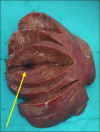Liver lesions detected in a hepatitis B core total antibody-positive patient masquerading as hepatocellular carcinoma: a rare case of peliosis hepatis and a review of the literature
- PMID: 28990003
- PMCID: PMC5620477
- DOI: 10.14701/ahbps.2017.21.3.157
Liver lesions detected in a hepatitis B core total antibody-positive patient masquerading as hepatocellular carcinoma: a rare case of peliosis hepatis and a review of the literature
Abstract
Peliosis Hepatis (PH) is a rare vascular disorder of the liver, characterized by the presence of cystic blood-filled cavities distributed throughout the hepatic parenchyma. The pathogenesis of PH remains controversial. The preoperative diagnosis of PH is difficult, due to the non-specific imaging characteristics of PH and almost all cases are diagnosed on histology post resection. This study presents a case of PH masquerading as hepatocellular carcinoma (HCC). The patient is a 45-year old Chinese lady, who presented with transaminitis. She was found to be hepatitis B virus core total antibody-positive with an alpha-fetoprotein (AFP) of 29.4 ng/ml. Triphasic liver computed tomography showed several arterial hypervascular lesions and hypoenhancing lesions on the venous phase, particularly in the segments 6/7. Subsequently, a magnetic resonance imaging scan showed multiple lesions in the right hemiliver with an indeterminate enhancement patterns. Subsequently, she decided to undergo a resection procedure. Histopathology revealed findings consistent with PH with some unusual features. This case demonstrates a clinical conundrum, in which PH presented with a raised AFP, in a patient with risk factors for the development of HCC. The clinical suspicion of PH should be high in patients, who present with multiple hepatic lesions with variable enhancement patterns.
Keywords: Hepatis; Hepatocellular carcinoma; Hepatoma; Peliosis.
Figures




Similar articles
-
A rare case of peliosis hepatis in a patient with chronic renal failure and renal cell carcinoma.Clin J Gastroenterol. 2020 Jun;13(3):403-407. doi: 10.1007/s12328-019-01068-5. Epub 2019 Nov 11. Clin J Gastroenterol. 2020. PMID: 31713159
-
Peliosis Hepatis Shows Isometabolism on (18)F-FDG PET/CT: Two Case Reports.Nucl Med Mol Imaging. 2014 Dec;48(4):309-12. doi: 10.1007/s13139-014-0281-5. Epub 2014 Jun 6. Nucl Med Mol Imaging. 2014. PMID: 26396637 Free PMC article.
-
A case of intra-abdominal hemorrhage secondary to peliosis hepatis.Int J Surg Case Rep. 2015;7C:47-50. doi: 10.1016/j.ijscr.2014.12.030. Epub 2014 Dec 30. Int J Surg Case Rep. 2015. PMID: 25576958 Free PMC article.
-
Focal peliosis hepatis in a colon cancer patient resembling metastatic liver tumor.World J Gastroenterol. 2012 Nov 7;18(41):5999-6002. doi: 10.3748/wjg.v18.i41.5999. World J Gastroenterol. 2012. PMID: 23139621 Free PMC article. Review.
-
Peliosis hepatis: Personal experience and literature review.World J Gastroenterol. 2015 Dec 14;21(46):13188-94. doi: 10.3748/wjg.v21.i46.13188. World J Gastroenterol. 2015. PMID: 26675327 Free PMC article. Review.
Cited by
-
Imaging presentation and postoperative recurrence of peliosis hepatis: A case report.World J Clin Cases. 2021 Jul 6;9(19):5197-5202. doi: 10.12998/wjcc.v9.i19.5197. World J Clin Cases. 2021. PMID: 34307567 Free PMC article.
-
Liver haematoma as a presentation of peliosis hepatis.BMJ Case Rep. 2019 Feb 22;12(2):e226737. doi: 10.1136/bcr-2018-226737. BMJ Case Rep. 2019. PMID: 30798271 Free PMC article.
References
Publication types
LinkOut - more resources
Full Text Sources
Other Literature Sources
